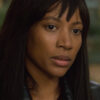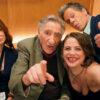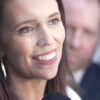There’s one suspicious knock on the door that is really all you need to know about the life that awaits outside of Casey’s bedroom in “We’re All Going to the World’s Fair,” angry that at 3 am she’s on her computer and playing her music a little too late. You can assume it’s her father, but writer/director Jane Schoenbrun leaves it vague, the only thing being specific is that it’s harsh and unsympathetic, making it understandable that the young woman (indelibly played by Anna Cobb) feels far more welcome in the world that she can escape into on her computer where she’s attracted to the World’s Fair Challenge, a competition of sorts among an online community to post scary videos designed to elicit an emotional reaction when the real world can leave them cold. Anna will shed blood, pricking herself with the end of a pin, and scream quite literally into the void, knowing that it’ll reach someone and it’s only fair when so many of the videos have helped her cope when there seems to be few around to feel what she does.
“We’re All Going to the World’s Fair” is Schoenbrun’s feature debut after years of building real-world coalitions of filmmakers with their work at Kickstarter as the senior film lead and the omnibus series The Eyeslicer, bringing together hundreds of filmmakers to follow their creative instincts no matter where they’d lead, and though it involves just two actors (the other being Michael J. Rogers), it becomes even more moving when considered as extension of everything that its director has done before, envisioning all the possibilities of technology and creative expression as democratizing forces.
Still, the film provocatively explores the danger lurking when connections are made virtually rather than physically, giving like-minded people the knowledge that they aren’t alone and an ability to converse yet remain frustratingly stuck in certain realities that can’t be changed in the outside world. In her teenage years, Casey isn’t so much absorbed by the online world when it’s been such a part of her life from a young age as inevitably disappointed by why the rest of her existence can’t be more like it and while she’s become numb to what unfolds outside of her computer screen, what happens within it touches her deeply, making it scary when she finds the limits to the reach of her devices.
Shortly before the film’s premiere at Sundance, Schoenbrun and Cobb spoke about their most fruitful collaboration and opening up the production process to discoveries throughout, as well as losing themselves in the making of it and coming out stronger on the other side.
How did this come about?
Jane Schoenbrun: I’ve been working up the courage to make my first feature film it feels like for my entire life. The origin story of the film honestly starts when I was a young person spending a lot of my time reading and posting in online forums. The film is not autobiographical, but it is initially partially inspired by a really weird interaction I had when I was around 13 years old and befriended an older man who would comment on my stories when I posted them on a horror fan fiction message board, eventually crossing some very strange boundaries over the internet trying to convince me that vampires were real. This strange incident in this relationship, which was both unreal and very intimate at the same time, always really stuck with me, and I wanted to look at this online creative space, specifically at this online community called the Creepypasta Community to ask some questions about identity online. The internet in general is a place it’s where young artists can find a voice, but where truth and fiction are often quite nebulous.
How much of this world needed to be created before you bring Anna into it? Because I imagined that there was some interaction on the set with the videos and the online component.
Jane Schoenbrun: The mythology in the film is really only glimpsed partially in the movie, which was on purpose. I wanted to recreate this feeling that you can sometimes have when you stumble upon a really dense online world, or wormhole, or Creepypasta universe where when you start reading about it, you’re seeing all of these foreign terms and ideas and this dense mythology that’s been built out by all of these different voices over such a long time. That can feel overwhelming and in a way that I think only the internet can feel [like], so I wanted the film to reflect that and drop viewers into the deep end of this really dense mythology, but I also didn’t want to be making it up. It really took a long time to do everything from writing a fake Wikipedia page with the full history of this entire Creepypasta in the film to building up different storylines that aren’t even in the film.
Then right before we shot the actual film, we spent a few months making a lot of the videos that the character watches and populate this world because we really wanted a lot of actual interaction with screens on set. If there is a key image in the movie, it’s just the screen itself, the glow of the screen, and the interaction late at night between a person alone in their room and the computer screen that they’re staring into, so it was really important that we weren’t, as much as possible, putting those things in later. We really wanted to have live on set these screens for Anna and the other actors in the film to interact with.
Anna, was there anything that was key to helping you figure out who this character was?
Anna Cobb: The biggest thing I was trying to do is pinpoint Casey’s energy rather than the way that she spoke or the way that she would react to things. In order to do that, it’s just about script analysis and really trying to find out her given circumstances and try to understand what happened before the script, like what got her to this point? I was never really aware about the Creepypasta community before doing this film, so having to learn all about it and then actually growing this attachment to it is something I’m going to take for life, and it’s one thing to act with another person, but just to take [things] as is, [like] this was like my world, let’s just say I didn’t know that I was Anna Cobb at that moment. It was genuine that I was Casey at that moment, reacting to all this material that was given into me.
Once Anna comes in, does your ideas for the character change, Jane?
Jane Schoenbrun: That was always my hope that the real person we cast would bring a lot of themselves to the role, which Anna certainly did. We had this very long casting process and it was so important to me I was ready to delay production until we found somebody that felt like they weren’t just going to become the character on the page, but that they were going to bring so much more to the film. Anna was just this perfect combination of such a distinctive voice and this artistic creative actor, somebody who just inhabited just in her eyes what the character was going through. So the script really was rewritten a little bit after she came on board and we worked a ton together in the lead-up to filming.
We did tons of improv exercises. We had had Anna make YouTube videos in character to get into the mode of Casey, and we talked so much about who this person was and what she was going through. It got to the point where by the time we got on set we had such a familiarity shared between us and what we were trying to explore through the character that even though the film in a lot of ways is very formalist, I really wanted to give Anna so much space and so much trust and create an environment where she could improvise and where she could fully live in the space of the world of the film.
Because this is a first feature for both of you, in spite of all the experience that you have, it seems like an exciting opportunity to create your own way of working together. What was that like?
Jane Schoenbrun: That was the thing that excited me most about trying to figure out my first film, was to not act out of fear and not try to put something together that was structured the way that you were “supposed to make a movie,” but to really create an environment where I thought that I [and others] could thrive creatively, so every step of putting the crew together and the vision for the film was enacted with that in mind. [I thought a lot about] the number of shots in the film — I really learned that the scenes that we were shooting for that more “traditional shot, reverse-shot” [sequencing] which there is a little bit of in the film, but not so much, it’s just so hard when you’re setting up for eight different angles to create the kind of lightning-in-a-bottle energy that I really wanted [Anna] to create, so it was all about trying to create a space where the both of us could just feel like kids playing and being creative, and I hope for Anna, it was this experience where [she] feel empowered to not be self-conscious. That was one of the hardest things for me.
Anna Cobb: Yeah, and Jane, of course, had wonderful professionalism and we worked very hard, but what I’ll always remember about Jane is that she was able to be my friend. I hate to be cheesy, and we are obviously still very good friends, but as an actor, you can’t possibly give a good performance if you’re not feeling like you can be vulnerable around [the director] and Jane never judged me or made me feel like I can’t be this way or sensitive. She never was hammering down a nail, but rather had open arms. So from day one, I just remember never feeling self-conscious and I deeply valued that.
Jane Schoenbrun: I was also just so incredibly grateful to what Anna was willing to do to prepare for this role — the amount of work and care and thought that she put into it. When you watch the movie, it’s a really brave, raw, and very, very emotionally plugged in performance. And for Anna to have gone there in her first feature and committed so deeply was just such a gift and something that I didn’t take lightly. As scary as it was for me to put myself out there and make a film, for Anna, it must have been even more of a responsibility to take on, so I was just so thankful every day for how much she was giving to it.
I don’t want to spoil any of the big moments in the film, but there is a big musical number. Was that in the script from the start or did it grow out of something during shooting?
Jane Schoenbrun: It’s a good story — that song [“Love In Winter”] is written by an artist called Fredrick Cuevas, who records music under the name FRDRK, and he is someone I reach out to over the internet. He produced an album that is served to become like a cult classic on the internet called, “My Teenage Dream Ended” [performed] by the pop star Farrah Abraham, and there’s just something about the sound of that album that felt very internet-y to me. It had this fractured take on pop music that just felt in the DNA of the tone I was trying to explore in the film, so I e-mailed him and the original idea was for FRDRK to write music, and then we were going to find a vocalist to put vocals on the song, and Anna was just going to dance to the song in the film. But what actually happened was FRDRK sent me the backing track, and I just sat in my living room with this song and starting singing the lyrics that I had written that were in the script until I had a melody that I was really excited about. Then I sent Anna a very embarrassing voice memo of me singing along to the song for her to practice…
Anna Cobb: I actually thought it was beautiful, much better than my singing. Jane has a melodic voice compared to mine, so…
Jane Schoenbrun: Then we rehearsed some scenes in the film over and over again in the lead-up to production, but Anna is actually a great dancer, as you can tell in the film. Her family once ran a dance studio for a little while, which is a total coincidence, and we practiced it just once. We were doing a lot of blocking and a lot of line running for scenes in the lead-up to production. And I asked Anna to prepare something as a first draft of that scene, and we filmed her performing about three weeks maybe before we shot the film. The second I saw her, I said, “Don’t do that again. Don’t practice anymore.” Because I wanted it to feel as raw as it does in the movie.
Anna Cobb: I don’t know if it was really nice to watch. Every time I watch it on the screen, I’m like, “Anna, you look like a fool.” But I wanted to look like a fool because those are the moments you feel most alive in life. But mostly, I’m not a singer, and I would never call myself a singer, but I knew that Casey was not trying to be, so this was just Casey being Casey, and as much as I could, I was trying to have a good time and I hope that translated well on screen.
Jane Schoenbrun: I told Anna that at some point during production, I was going to ask her to scream at the top of her lungs, so she should be ready to do that, but I didn’t tell her until the day we shot that scene exactly when she was supposed to scream, so if it feels pretty organic in the film, it’s just what came out in that moment.
It’s just one fantastic moment of many in this film. What’s it like putting it out into the world?
Anna Cobb: For me at least, I feel unbreakable. I feel really amazing. This is a great start to the year, and I remember the day that Jane called me about getting into Sundance on November 13th, and since then I’ve just been counting down the days, so it’s like, “Thank God we made it here.” I just feel blessed to be able to talk to you right now and to have this moment. It’s such a pure moment of joy.
Jane Schoenbrun: Yeah, it’s totally surreal. You make something, which was a decision that I made years ago now, and you hope that you made something that speaks in some way to somebody else, so the final part of that equation is finally sharing it with others and it’s bittersweet and a little terrifying and so beautiful to know that others will finally get to see this thing that no one more than me and Anna put so much into.
“We’re All Going to the World’s Fair” will screen once more at the Sundance Film Festival virtually during a 48-hour window beginning on February 2nd.




